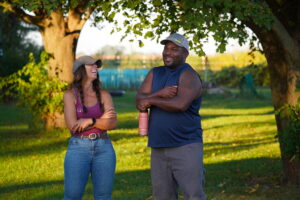‘We’ve come up with a better plan’
Union holds tandem town halls ahead of Nov. 4 bond referendum
- Union Community School District Board of Education President Ben Schemmel addresses the audience on Wednesday, Sept. 24, during a bond referendum town hall held in the Union Middle School auditorium. The district’s $18.5 million public measure will be on the Nov. 4, 2025, city-school election ballot. Last year, the district failed to pass a similar measure by a mere six votes. PHOTO BY RUBY F. MCALLISTER
- A district parent asks a question during the Q&A portion of the town hall. PHOTO BY RUBY F. MCALLISTER
- Union Superintendent John Howard, right, addresses district facility improvements while flipping through presentation slides during a bond referendum town hall held in Dysart on Sept. 24. Roughly two dozen members of the public attended the meeting. PHOTO BY RUBY F. MCALLISTER
- As pictured, Union’s existing bus barn in La Porte City does not fully shelter the district’s fleet. The district would build a new bus barn at a cost of roughly $2.2 million if its $18.5 million bond referendum is approved by a supermajority of voters during the upcoming city-school election. PHOTO COURTESY OF UNION COMMUNITY SCHOOL DISTRICT
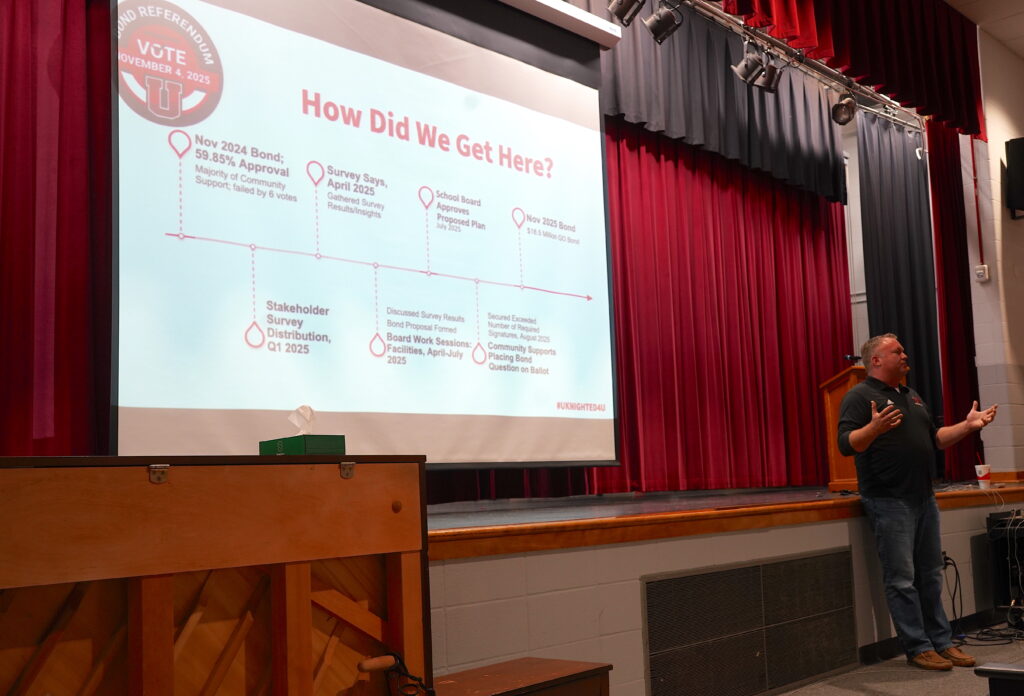
Union Community School District Board of Education President Ben Schemmel addresses the audience on Wednesday, Sept. 24, during a bond referendum town hall held in the Union Middle School auditorium. The district’s $18.5 million public measure will be on the Nov. 4, 2025, city-school election ballot. Last year, the district failed to pass a similar measure by a mere six votes. PHOTO BY RUBY F. MCALLISTER
DYSART – The Union Community School District recently hosted a pair of town halls in an effort to further the community’s understanding of the $18.5 million general obligation bond referendum that will be on Tuesday, Nov. 4, 2025 city-school election ballot.
“We feel this year we’ve come up with a better plan,” Union Board of Education President Ben Schemmel told the audience during the Wednesday, Sept. 24 town hall held in the middle school auditorium in Dysart. More than two dozen members of the public including the local mayor were in attendance for the hourlong meeting, along with Union Superintendent John Howard and several school board members.
In 2024, the district failed to pass a similar $20.5 million bond referendum, falling just six votes shy of the required 60% supermajority. One of the first slides Schemmel showed the audience Wednesday evening – titled “How Did We Get Here?” – was a brief timeline of events from the 2024 bond to the present, including a stakeholder survey pushed out in early 2025, work sessions over the spring and summer utilizing said survey results, and the new plan publicized this past July.
Schemmel said the current bond referendum, like the 2024 bond, prioritizes student safety and accessibility as well as modernization upgrades.
Following Schemmel’s opening remarks, Superintendent Howard displayed a series of photographs illustrating the deteriorating and/or subpar conditions present across the district, including bathroom facilities located near the auditorium doors.
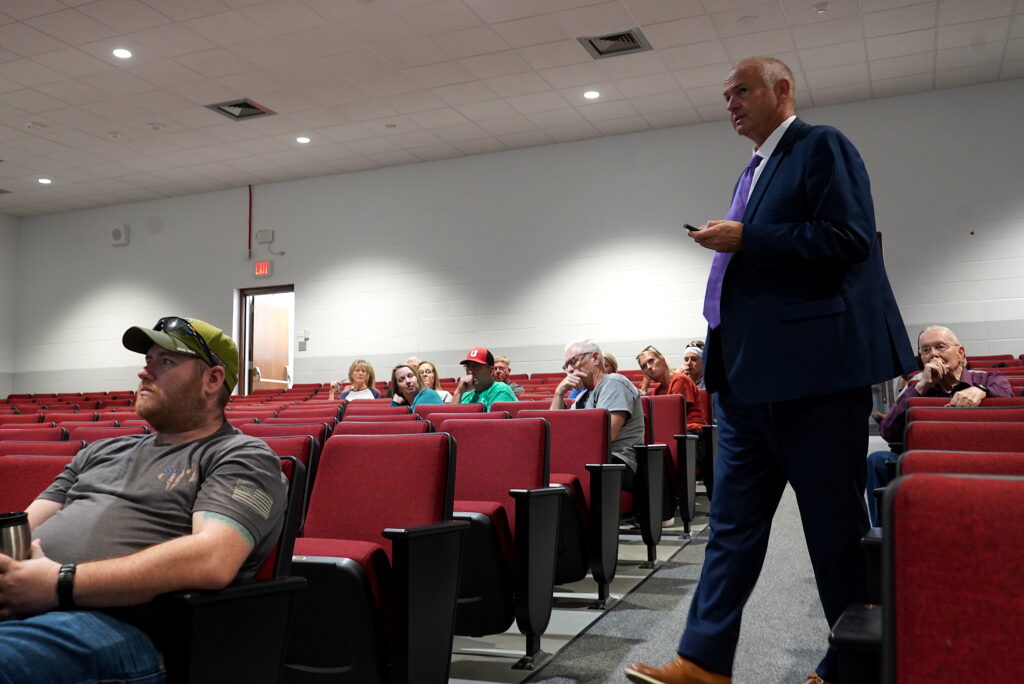
Union Superintendent John Howard, right, addresses district facility improvements while flipping through presentation slides during a bond referendum town hall held in Dysart on Sept. 24. Roughly two dozen members of the public attended the meeting. PHOTO BY RUBY F. MCALLISTER
“If you go right out here, these two bathrooms are not accessible for handicapped people. I measured the entrance the other day and it’s like 33 inches. ADA accessibility is 36 inches,” he said.
The superintendent also explained why a new auxiliary gymnasium – part of the 2024 bond referendum – was not part of the 2025 proposal.
“The gym was a contentious issue, so the board decided to take that off and instead, essentially, [replace it with] a new bus barn and a new greenhouse,” Howard said as he clicked through photographs of the current bus barn in which the back portion of a school bus did not fit inside the barn.
“This is actually how buses have to be stored because there’s not enough room in the bus barn,” Howard continued. “This is in La Porte City. Obviously there’s no place to work on the buses, we have no bus lift.”
He also addressed recent news that the high school needed significant mold remediation.
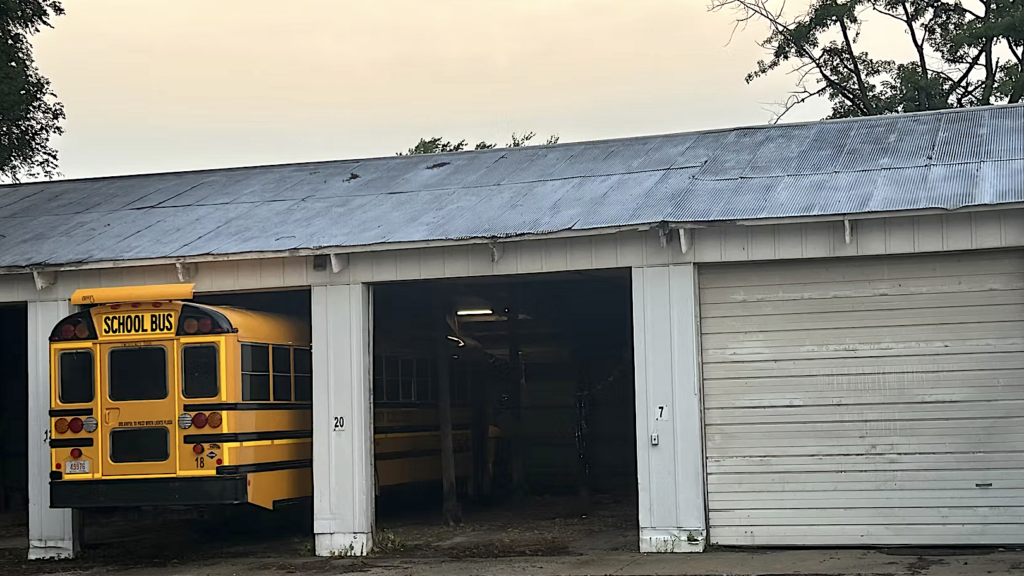
As pictured, Union’s existing bus barn in La Porte City does not fully shelter the district's fleet. The district would build a new bus barn at a cost of roughly $2.2 million if its $18.5 million bond referendum is approved by a supermajority of voters during the upcoming city-school election. PHOTO COURTESY OF UNION COMMUNITY SCHOOL DISTRICT
“The biggest thing I can tell you is it was not a … conspiracy – that we just found the mold, that we just communicated the mold because we have a bond issue coming up. That is not the case,” he said. “All told, between everything we had to throw away, everything we had to replace, my guess is [the cost] is going to be a quarter million dollars. That is a quarter million dollars, luckily, that we had saved up through our SAVE [Secure an Advanced Vision for Education] and PPEL [Physical Plant and Equipment Levy], but the problem with that is … we use a quarter million dollars here, what are we not buying for our kids?”
Howard also mentioned locating both the home and visitor locker rooms at the high school on the same side and same level as another change from the 2024 bond to the 2025 bond.
“Otherwise, it’s a pretty similar project in terms of last year.”
All four buildings to benefit
Howard and Schemmel then addressed how each of the district’s four buildings – high school, middle school, La Porte City Elementary, Dysart-Geneseo Elementary – would be affected if the bond were to pass this time around.
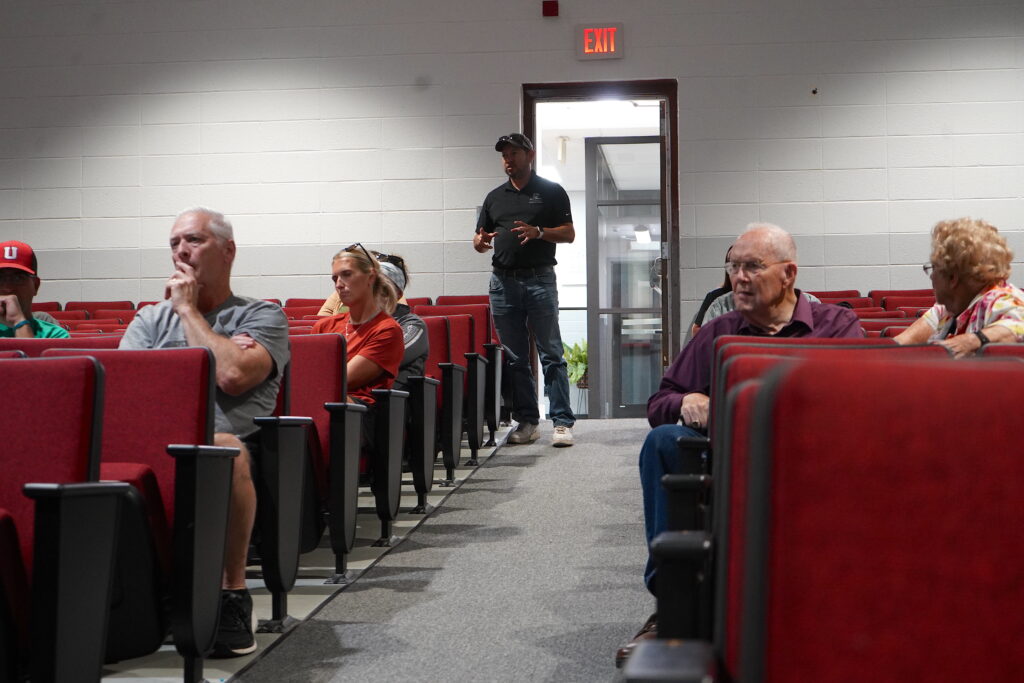
A district parent asks a question during the Q&A portion of the town hall. PHOTO BY RUBY F. MCALLISTER
“It was imperative [to] the board that we touch, that we improve every single building in the district. This plan does that, plus a new bus barn,” Howard said.
According to the town hall slides, the following issues would be addressed by the 2025 bond referendum were it to pass.
-High school: The HVAC systems, electrical systems, and roof would be replaced. Extensive renovations would also take place on the interior classrooms, media center, kitchen and cafeteria, and restrooms. The existing wrestling room and boys locker room would convert to a space that features four accessible locker rooms, two offices for coaches, a room for officials, and storage. A new wrestling room would be constructed, allowing consolidation of the boys and girls programs. A new state-of-the-art greenhouse would also be built.
-Middle school: Upgrades to HVAC systems, roof repairs, restroom renovations, and the installation of new door hardware.
-Elementary schools: Dysart-Geneseo Elementary and La Porte City Elementary would receive updates to mechanical systems, along with new fire alarms, new classroom door hardware, and a new public address system.
-Bus barn: The new facility would house six buses, feature an area for maintenance, and better protect Union’s fleet.
“They’re not sexy improvements,” Schemmel explained, but rather “common improvements” necessary to keep a school district’s infrastructure up and running. He cited the much-needed roof work at the middle school as one example.
The entire roof, Schemmel and Howard explained, was replaced in 1999 with some sections further replaced in 2011 following the derecho. Today, nine out of 12 sections need to be replaced at a cost of roughly $800,000.
“When you walk around the school, everybody has their own bucket,” Schemmel said. “They put the buckets out in the hallway. They put the buckets out in the classroom. That’s the complaint you get from the teachers when you go to your kids’ conferences [and ask], ‘Hey, what are a few things [the school board could do] that could make a little bit of a difference?’ [Teachers reply,] ‘Could our roof not leak?'”
Cost breakdown
Howard and Schemmel then broke down bond referendum spending per building with Howard explaining the entire project’s price tag is set at $25.8 million: $18.5 million from bond revenue, if passed, and $7.3 million from future SAVE revenue (sales tax).
“We’re not asking for $25.8 million,” Howard said. “The board is asking for $18.5 million. I know that’s a lot of money. I know that’s a tax increase. But, these are important things to do. … The good thing about SAVE and borrowing off of SAVE, it does not impact your property tax. It’s not property tax-dependent. It is a sales tax. It is a state sales tax.”
Howard then brought up a slide designating where the $25.8 million would be spent based on projected costs. The bulk of the funds – 49% or roughly $12.9 million – would go towards high school infrastructure needs; 14% (~$3.6 million) would be earmarked for high school “educational enhancements” including replacement of the greenhouse and a full renovation of both the Family and Consumer Sciences (FCS) and Life Science classrooms; 18% (~$4.6 million) would fund additions and locker room renovations at the high school including a new kitchen addition; 6.6% (~$1.7 million) would fund improvements at the middle school including new safety and security systems, roof repairs, A/C in the gym, and restroom renovations; 3.2% (~$825,000) would be used to improve the elementary buildings; and 8.5% (~$2.2 million) would be used to build a new bus barn in La Porte City.
Tax impact
Garrett Pochop with the investment bank Piper Sandler also briefly addressed the audience during the town hall, explaining the bond referendum’s tax impact. For context, he said in 2024 around 34-35 school districts in Iowa had a bond referendum on the ballot; this year the number of districts is closer to 44.
“Union has a good mixture between both residential and agricultural,” he explained, with residential equating to roughly 44-45% of the tax base, ag property around 47%, and the remainder commercial/industrial. He also said Union’s tax rate is on the lower end compared to neighboring districts.
Using a series of charts, Pochop said the tax impact of Union’s 2025 bond referendum, if passed, would be a levy rate increase of $2.60 per $1,000 of a property’s taxable value. Using the example of a home assessed at $100,000 — and taking into consideration both the rollback and less the value of the Homestead Tax Credit — the annual additional tax would be $110.71.
After briefly addressing the impact to commercial properties, he turned to the impact on ag land.
“This I would say is maybe the … hardest to understand,” he prefaced before stating the “blended average assessed value per acre is $1,964 per acre.” He said the State of Iowa further adjusts that with a rollback rate.
“On the annual basis, per acre [the increase] would be around $3.77.”
During the Q&A which followed the formal presentation, an ag land owner in the district compared the tax impact between a hypothetical residential property and a tract of farmland.
“Somebody that owns 500 acres of ground, 600 acres of ground – throw their house on there, throw their building site on there, machine sheds, grain bins. [The tax impact] looks way different than your 100-some dollars a year [a residential owner pays],” the man said.
“Yeah, no, I would agree,” Pochop responded. “I wouldn’t argue that point. … There’s always the notion of what’s fair, and, I think, fair is always in the eye of the beholder. Is the property tax system, the way that it’s designed, is it fair? Again, that’s kind of up for judgment.”
He later added, “You’re only paying 10% of what the market value is if you own ag land. So total market value – and, again, I understand it’s on paper – but what is somebody worth? … I understand that might not be liquid cash. I totally understand that. But on paper, that person would be, likely, a multimillionaire … It’s a complicated answer to a simple question that I think always comes back to fairness and equity, and I don’t have a perfect answer for that.”
“I can promise you that there’s a gut check amongst everybody on the board,” Schemmel said in a follow-up to Pochop’s response. “I believe agriculture touches all of our lives and how we put groceries on our tables. It just depends on what hat we’re wearing. … Property tax is a big burden.”
Later, Pochop said, “If there’s an ag owner [whose] property taxes for this bond … are going up $3-$4-$5,000, then that would mean that person probably owns 1,000 acres of land – which I’m sure there probably are people in the district that do. … Everybody appreciates the ag community and what they do for the community, the state as a whole. … That’s a big part of why your district has a lower levy rate in comparison to maybe neighboring districts [because] you have a strong tax base of both – not just residential, but agricultural as well.”
Another question came from Steven Stoner, a member of the Dysart City Council, who wanted to know what the total price tag was for improvements already completed at the Dysart buildings.
The total since 2022, Howard replied, was roughly $1.5 million; in the last five years, almost $2.8 million. Such improvements include (among others) updating the D-G kitchen floor; resurfacing the D-G parking lot; painting D-G’s hallways, gym and cafeteria; installing new interior security doors at both buildings; HVAC work at the middle school; field and fencing updates at the middle school; $300,000 toward mold remediation and reconstruction at the middle school; and $100,000 toward the new playground at D-G.
“I – and the board – have made a conscious effort to improve [Dysart’s buildings] since I’ve been here. I started in July of 2022,” Howard said. “Now is it sexy? Is it a brand new building? Is it a brand new classroom? No, it’s not.”
All of the projects listed were paid for using SAVE or PPEL funds.
Why now?
At several points during the town hall, Howard and Schemmel addressed the simple, rhetorical question of ‘Why now?’
“Our goal is clear,” Schemmel said as he read from a slide quoting himself. “We’re committed to creating schools that are safe, and adaptable – places that reflect the pride and values of our communities. This plan is about ensuring our students have every opportunity to learn, grow, and succeed in facilities that serve them well.”
“This plan represents more than construction projects,” Howard’s slide read, “It’s an investment in our students, our staff, and the future of our communities. It reflects the priorities we heard from our educators and staff, families, and community members and ensures our facilities remain safe, efficient, and adaptable for the years ahead.”
A few minutes after the town hall’s scheduled end time of 7 p.m., Howard swiftly wrapped things up, thanking the audience while also offering to stay late to answer any further questions.
For those who could not attend the Dysart town hall or the second town hall that took place last week at the high school in La Porte City, the district has a comprehensive website dedicated to the 2025 bond referendum available at uknighted4u.org. Per the website, registered voters who reside in the Union district have several options to vote, including on Election Day, Tuesday, Nov. 4, 2025, from 7 a.m. to 8 p.m.
Registered voters can currently request a mailed absentee ballot through their county auditor’s office. The last day to request a mailed absentee ballot is Monday, Oct. 20. Ballots must be received by the auditor’s office before polls close on Nov. 4.
In-person absentee voting at county auditor’s offices began this week on Wednesday, Oct. 15, and will be available weekdays through Monday, Nov. 3, during regular business hours.

